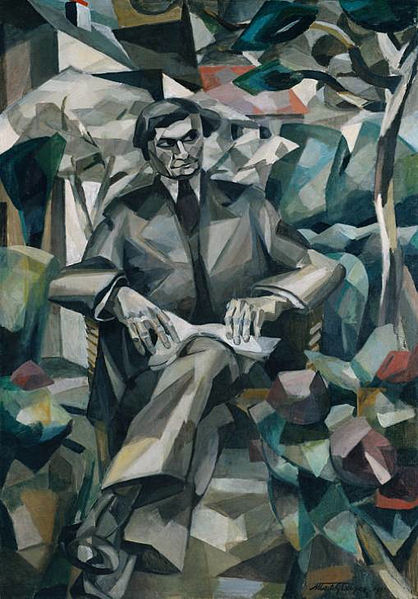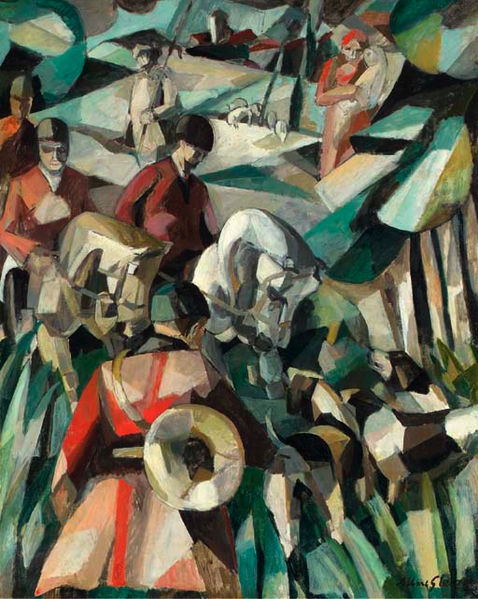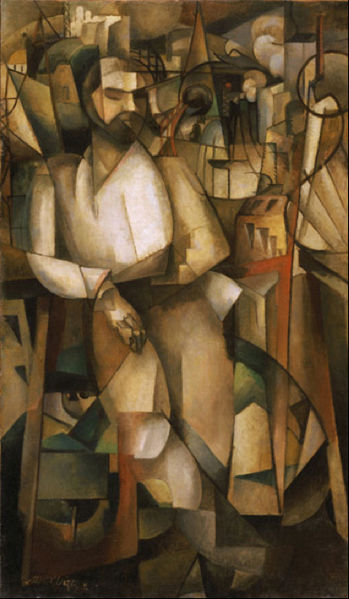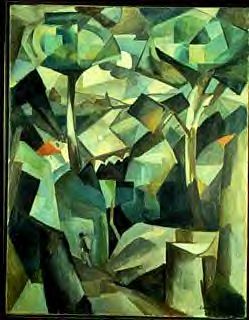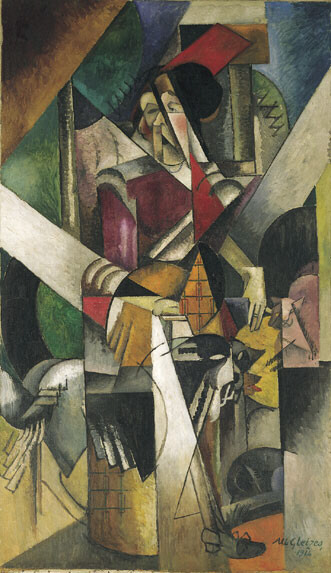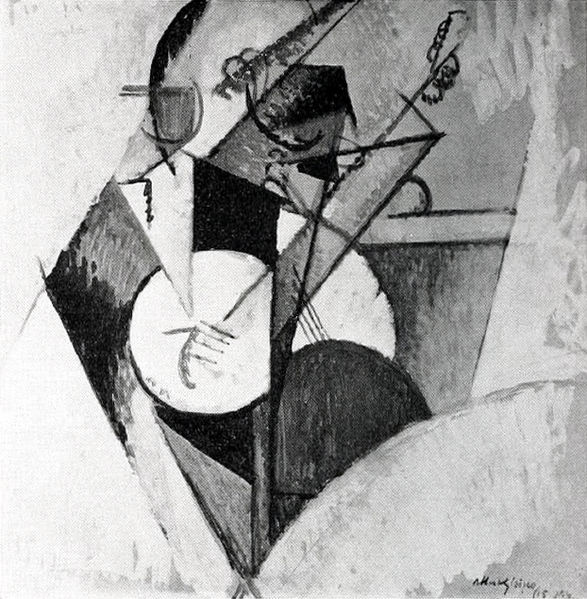<Back to Index>
- Painter and Philosopher Albert Gleizes, 1881
PAGE SPONSOR
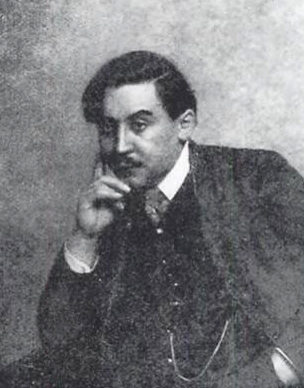
Albert Gleizes (Paris, 8 December 1881 – Avignon, 23 June 1953), was a French artist, theoretician, philosopher, a founder of Cubism and an influence on the School of Paris. Albert Gleizes and Jean Metzinger wrote the first major treatise on Cubism, Du "Cubisme", 1912. Gleizes was a founding member of the Section d'Or group of artists. He was also a member of Der Sturm, and his many theoretical writings were originally most appreciated in Germany, where especially at the Bauhaus his ideas were given thoughtful consideration. Gleizes spent four crucial years in New York, and played an important role in making America aware of modern art. He was a member of the Society of Independent Artists, founder of the Ernest - Renan Association, and both a founder and participant in the Abbaye de Creteil. Gleizes exhibited regularly at Léonce Rosenberg’s Galerie de l’Effort Moderne in Paris; he was also a founder, organizer and director of Abstraction - Création. From the mid 1920s to the late 1930s much of his energy went into writing (e.g., La Peinture et ses lois (Paris, 1923), Vers une conscience plastique: La Forme et l’histoire (Paris, 1932) and Homocentrisme (Sablons, 1937).
Born Albert Léon Gleizes and raised in Paris, he was the son of a fabric designer who ran a large industrial design workshop. He was also the nephew of Léon Comerre, a successful portrait painter who won the 1875 Prix de Rome. The young Albert Gleizes did not like school and often skipped classes to idle away the time writing poetry and wandering through the nearby Montmartre cemetery. Finally, after completing his secondary schooling, Gleizes spent four years in the 72nd Infantry Regiment of the French army (Abbeville, Picardie) then began pursuing a career as a painter. Gleizes began to paint self - taught around 1901 in the Impressionist tradition. His first landscapes from around Courbevoie appear particularly inspired by Sisley or Pissarro. Although clearly related to Pissarro in technique, Gleizes' particular view points as well as the composition and conception of early works represent a clear departure from the style of late Impressionism. The density with which these works are painted and their solid framework suggest affinities with Divisionism which were often noted by early critics.
Gleizes was only twenty - one years of age when his work titled La Seine à Asnières was exhibited at the Société Nationale des Beaux-Arts in 1902. The following year Gleizes exhibited two paintings at the Salon d'Automne. In 1905 Gleizes was among the founders of l'Association Ernest - Renan, a union of students opposed to military propaganda. Gleizes was in charge of the Section littéraire et artistique, organizing theater productions and poetry readings. At the Musée des Beaux - Arts de Lyon (Salon de la Société Nationale des Beaux - Arts, 1906), Gleizes exhibited Jour de marché en banlieue. Tending towards 1907 his work evolved into a Post - Impressionist style with strong Naturalist and Symbolist components.
Gleizes and others decide to create an association fraternelle d'artistes and rent a large house in Créteil. The Abbaye de Créteil was a self supporting community of artists that aimed to develop their art free of any commercial concerns. For nearly a year, Gleizes along with other painters, poets, musicians and writers, gathered to create. A lack of income forced them to give up their cherished Abbaye de Créteil in early 1908 and Gleizes moved to rue du Delta near Montmartre, Paris. In 1908 Gleizes exhibited at the Toison d'Or in Moscow. The same year, showing a great interest in color and reflecting the transient influence of Fauvism, the work of Gleizes became more synthetic.
Gleizes' Fauve - like period was very brief, lasting several months, and even when his paint was thickest and color brightest, his concern for structural rhythms and simplification was dominant. His geometric simplifications at this time were more akin to Pont - Aven School and Les Nabis principles than to Paul Cézanne. His landscapes of 1909 are characterized by the reducing of forms of nature to primary shapes.
During the summer of the same year his style became linear and stripped, broken down into multiple forms and facets with attenuated colors, close to that of the painter Henri Le Fauconnier. In 1910 a group began to form which included Gleizes, Metzinger, Fernand Léger and Robert Delaunay. They met regularly at Henri le Fauconnier's studio on rue Notre - Dame - des - Champs, near the Boulevard de Montparnasse. These soirées would often included writers such as Guillaume Apollinaire, Roger Allard, René Arcos, Paul Fort, Pierre - Jean Jouve, Alexandre Mercereau, Jules Romains and André Salmon. Together with other young painters, the group wanted to emphasize a research into form, in opposition to the Neo - Impressionist emphasis on color. From 1910 onward, Albert Gleizes was directly involved with Cubism, both as an artist and principal theorist of the movement.
Gleizes' evolvement in Cubism saw him exhibit at the twenty - sixth Salon des Indépendants in 1910. He showed his Portrait de René Arcos and L'Arbre, two paintings in which the emphasis on simplified form had already begun to overwhelm the representational interest of the paintings. The same tendency is evident in Jean Metzinger's Portrait of Apollinaire in the same Salon. When Louis Vauxcelles wrote his initial review of the Salon he made a passing and imprecise reference to Gleizes, Jean Metzinger, Robert Delaunay, Fernand Léger and Henri le Fauconnier, as "ignorant geometers, reducing the human body, the site, to pallid cubes." Guillaume Apollinaire, in his account of the same salon at the Grand Palais (in L'Intransigeant, 18 March 1910), remarked "with joy" that the general sense of the exhibition signifies "La déroute de l'impressionnisme," in reference to the works of a conspicuous group of artists (Gleizes, Delaunay, Le Fauconnier, Metzinger, André Lhote and Marie Laurencin). In Gleizes' paintings of the crucial year 1910, writes Daniel Robbins, "we see the artist's volumetric approach to Cubism and his successful union of a broad field of vision with a flat picture plane. [...] The effort to grasp the intricate rhythms of a panorama resulted in a comprehensive geometry of intersecting and overlapping forms which created a new and more dynamic quality of movement.
Gleizes then exhibited at the 1910 Salon d'Automne with the same artists, followed by the first organized group showing by Cubists, in Salle 41 of the Salon des Indépendants (Paris, 1911) together with Metzinger, Delaunay, le Fauconnier and Léger. The result was a public scandal which brought Cubism for the first time to the attention of the general public (Picasso and Braque were exhibiting in a private gallery selling to a small circle of connoisseurs). At the 1911 Salon d'Automne (room 8) Gleizes exhibited his Portrait de Jacques Nayral and La Chasse, with, in addition to the group of Salle 41, André Lhote, Marcel Duchamp, Jacques Villon, Roger de La Fresnaye and André Dunoyer de Segonzac. In the fall of that year, though the intermediary of Apollinaire, he met Pablo Picasso for the first time and joined the Puteaux Group which held meetings in the studio of Jacques Villon (Gaston Duchamp) and also included Villon's brothers, Raymond Duchamp - Villon and Marcel Duchamp, among others. Many of these artists also frequented the cafés Le Dôme, La Closerie des Lilas, La Rotonde, Le Select and La Coupole in Montparnasse.
Gleizes exhibited at the 1912 Salon des Indépendants; a show marked by Marcel Duchamp's Nude Descending a Staircase, No. 2, which itself caused a scandal even among the Cubists. This was followed by a group show at the Gallery Dalmau in Barcelona, another exhibit in Moscow (Valet de Carreau), the Salon de la Société Normande in Rouen, and the Salon de la Section d'Or, October 1912 at the Galerie de la Boétie in Paris.
1911 through 1912, drawing to some extent on theories of Henri Poincaré, Ernst Mach, Charles Henry and Henri Bergson, Gleizes began to represent the object, no longer considered from a specific point of view, but rebuilt following a selection of successive viewpoints (i.e., as if viewed simultaneously from numerous viewpoints, and in four dimensions). This technique of relative motion is pushed to a its highest degree of complexity in the monumental Le Dépiquage des Moissons, Harvest Threshing, (oil on canvas, 269 x 353 cm, ex-Guggenheim, New York, now at the National Museum of Western Art, Tokyo). This ambitious work, with Delaunay's City of Paris, is one of the largest paintings in the history of Cubism.
The Cubist contribution to the 1912 Salon d'Automne created a controversy in the Municipal Council of Paris, leading to a debate in the Chambre des Députés about the use of public funds to provide the venue for such barbaric art. The Cubists were defended by the Socialist deputy, Marcel Sembat. Albert Gleizes and Jean Metzinger, in preparation for the Salon de la Section d'Or, published a major defense of Cubism, resulting in the first theoretical essay on the new movement, entitled Du "Cubisme" (published by Eugène Figuière in 1912, translated to English and Russian in 1913).
In Du "Cubisme" Gleizes and Metzinger wrote: "If we wished to relate the space of the [Cubist] painters to geometry, we should have to refer it to the non - Euclidian mathematicians; we should have to study, at some length, certain of Riemann's theorems." Cubism itself, then, was not based on any geometrical theory, but corresponded better to non - Euclidean geometry than classical or Euclidean geometry. The essential was in the understanding of space other than by the classical method of perspective; an understanding that would include and integrate the fourth dimension. Cubism, with its new geometry, its dynamism and multiple view - point perspective, not only represented a departure from Euclid's model, but it achieved, according to Gleizes and Metzinger, a better representation of the real world: one that was mobile and changing in time. For Gleizes, Cubism represented a "normal evolution of an art that was mobile like life itself." In contrast to Picasso and Braque, Gleizes' intent was not to analyze and describe visual reality. Gleizes had argued that we cannot know the external world, we can only know our sensations. Objects from daily life ⎯ guitar, pipe or bowl of fruit ⎯ did not satisfy his complex idealistic concepts of the physical world. His subjects were of vast scale and of provocative social and cultural meaning. Gleizes' iconography (as of Delaunay, Le Fauconnier and Léger) helps to explain why there is no period in his work corresponding to analytic Cubism, and how it was possible for Gleizes to become an abstract painter, more theoretically in tune with Kandinsky and Mondrian than Picasso and Braque, who remained associated with visual reality.
Gleizes' intent was to reconstitute and synthesize the real world according to his individual consciousness (sensations), through the use of volumes to convey the solidity and structure of objects. Their weight, placement and effects upon each other, and the inseparability of form and color, was one of the principal lessons of Cézanne. Forms were simplified and distorted, each shape and color modified by another, rather than splintered. His concern was to establish weight, density and volumetric relationships among sections of a broad subject. Gleizes himself characterized the 1910 – 11 phase of his work as an "analysis of volume relationships," though it bears little relation to the traditional use of the word "analytical" in our understanding of Cubism.
A central theme of Du "Cubisme" was that access to the true essence of the world could be gained by sensations alone. The sensation offered by classical painting was very limited: to only one point of view, from a single point in space and frozen in time. But the real world is mobile, both spatially and temporally. Classical perspective and the formulations of Euclidean geometry were only conventions (to use Poincaré's term) that distance us from the truth of our sensations, from the truth of our own human nature. Man sees the world of natural phenomena from a multitude of angles that form a continuum of sensations in perpetual and continuous change. The Cubists' aim was to completely eschew absolute space and time in favor of relative motion, to grasp through sensory appearances and translate onto a flat canvas the dynamical properties of the four - dimensional manifold (the natural world). Only then could one achieve a better representation of the mobile reality of our living experience. If Gleizes and Metzinger write in Du "Cubisme" that we can only know our sensations, it is not because they wish to disregard them, but, on the contrary, to understand them more deeply as the primary source for their own work. In reasoning this way, Gleizes and Metzinger demonstrate that they are successors to Cézanne, who insists that everything must be learned from nature: "Nature seen and nature felt... both of which must unite in order to endure."
In February 1913, Gleizes and other artists introduced the new style of European modern art to an American audience at the Armory Show (International Exhibition of Modern Art) in New York City, Chicago and Boston. Gleizes published an article in Ricciotto Canudo's Montjoie entitled Cubisme et la tradition. It was through the intermediary of Cuando that Gleizes would meet the artist Juliette Roche; a childhood friend of Jean Cocteau and daughter of Jules Roche, an influential politician of the 3rd Republic.
With the outbreak of World War I, Albert Gleizes re-enlisted in the French army. He was put in charge of organizing entertainment for the troops and as a result was approached by Jean Cocteau to design the set and costumes for the William Shakespeare play, A Midsummer Night's Dream, along with Georges Valmier.
Discharged from the military in the fall of 1915, Gleizes and his new wife, Juliette Roche, moved to New York, where they would meet regularly with Francis Picabia, Man Ray, Marcel Duchamp and Jean Crotti (who would eventually marry Suzanne Duchamp). It is at this time that Gleizes witnessed, with a critical eye, the readymades of Marcel Duchamp. After a short stay at the Albemarle Hotel Gleizes and his wife settled at 103 West Street, where Gleizes painted a series of works inspired by jazz music, skyscrapers, luminous signs and the Brooklyn Bridge. Here Gleizes met Stuart Davies, Max Weber, Joseph Stella, and participated in a show at Montross Gallery with Duchamp, Crotti and Metzinger (who remained in Paris).
From New York City, the couple sailed to Barcelona where they were joined by Marie Laurencin, Francis Picabia and his wife. The group spent the summer painting at the resort area of Tossa del Mar and in December Gleizes had the first solo exhibition of his works at the Galería Dalmau in Barcelona. Returning to New York city in 1917, Gleizes began writing poetic sketches in verse and in prose, some of which were published in Picabia's Dada periodical 391. Traveling to Bermuda, he painted a number of landscapes but when the war in Europe ended he returned to France where his career evolved more towards teaching through writing and he became involved with the committee of the Unions Intellectuelles Françaises.
During the summer of 1918 at the Gleizes' rented house in Pelham New York, writes Daniel Robbins, Albert Gleizes came to his wife and said, "A terrible thing has happened to me: I believe I am finding God." This new religious conviction resulted not from any mystical visions but instead from Gleizes' rational confrontation of three urgent problems: collective order, individual differences and the painter's role. Although Gleizes did not join the Church until 1941, his next twenty - five years were spent in a logical effort not only to find God but also to have faith.
From 1914 and extending to the end of the New York period, Gleizes' nonrepresentational paintings and those with an apparent visual basis existed side by side, differing only, writes Daniel Robbins, in "the degree of abstraction hidden by the uniformity with which they were painted and by the constant effort to tie the plastic realization of the painting to a specific, even unique, experience." Gleizes approached abstraction conceptually rather than visually and in 1924 his intricate dialectic caused him to produce two amusing paintings which departed from his usual subject matter: the Imaginary Still Lifes, Blue and Green. In effect, writes Robbins, "Gleizes would have inverted Courbet's "Show me an angel and I will paint you an angel" to be "As long as an angel remains an unembodied ideal and cannot be shown to me, I'll paint it."
By 1919 the pre-war sense of the Cubist movement had been virtually shattered. Paris was overshadowed by a strong reaction against those visions of common effort and revolutionary construction which Gleizes continued to embrace, while the avant garde was characterized by the anarchic and, to him, destructive spirit of Dada. Neither alternative held any appeal for him and, with the Salons dominated by a return to classicism, his old hostility to Paris was constantly nourished. Gleizes' attempt to resuscitate the spirit of the Section d'Or was met with great difficulty, despite support by Alexander Archipenko, Georges Braque and Léopold Survage. His own organizational efforts were directed towards the re-establishment of a European - wide movement of abstract artists in the form of a large traveling exhibition, the Exposition de la Section d’Or, in 1920; it was not the success he had hoped for. Cubism was passé for younger artists, although Gleizes, on the contrary, felt that only its preliminary phase had been investigated.
It was the revival of the Section d'Or which ensured that Cubism in general and Gleizes in particular would become Dada's preferred target. Similarly, an effort to organize an artists' cooperative received the support of Robert Delaunay, but of no other major artists. The polemic resulted in the publication of Du cubisme et des moyens de le comprendre by Albert Gleizes, followed in 1922 by La Peinture et ses lois, within which appear the notion of translation and rotation that would ultimately characterize both the pictorial and theoretical aspects of Gleizes' art. His post - Cubist style of the twenties — flat, forthright, uncompromising — is virtually Blaise Pascal's "Spirit of Geometry."
Gleizes was in nearly every sense a maverick Cubist, perhaps the most unyielding of them all; both in his paintings and writings (which had a big impact on the image of Cubism in Europe and the United States). He developed a single - minded, thoroughly uncompromising Cubism without the diversion of a classical alternative. During the 1920s Gleizes worked on a highly abstract brand of Cubism. In addition to his shows at Léonce Rosenberg's L'Effort Moderne, the dealer - publisher Povolozky printed his writings. His art was indeed backed by a prodigious theoretical effluence, most notably in La Peinture et ses lois (first published in La Vie des Lettres, October 1922). Gleizes fused aesthetic, metaphysical, moral and social priorities to describe the status and function of art.
In La Peinture et ses lois writes Robbins, "Gleizes deduced the rules of painting from the picture plane, its proportions, the movement of the human eye and the laws of the universe. This theory, later referred to as translation - rotation, ranks with the writings of Mondrian and Malevich as one of the most thorough expositions of the principles of abstract art, which in his case entailed the rejection not only of representation but also of geometric forms." Flat planes were set in motion simultaneously to evoke space by shifting across one another, as if rotating and tilting on oblique axes. Diagrams entitled "Simultaneous movements of rotation and shifting of the plane on its axis" were published to illustrate the concept. His painting of 1920 – 1922, submitted to the same rigor, were not Cubist in any conventional sense; but they were Cubist in their concern with planimetric space, and in their relationship (synthesis) with subject - matter. Indeed, the abstract appearance of these compositions is misleading. Gleizes had always remained committed to synthesis. He described how artists had freed themselves from the 'subject - image' as a pretext to work from the 'subjectless - image' (nebulous forms) until they came together. The images known from the natural world combined with those nebulous forms were made 'spiritually human'. Though Gleizes considered his works as initially nonrepresentational and only afterwards as denotational.
Before World War I, Gleizes had always been identified as a Cubist avant garde. And during the twenties he continued to hold a prominent position, but he was no longer identified with the avant garde since Cubism had already been replaced by Dada and Surrealism. Even after historians began their attempts to analyze the vital role played by Cubism, the name of Albert Gleizes was always mentioned because of his early and important participation in the movement. Gleizes had never ceased to call himself a Cubist and theoretically a Cubist he remained. In many ways his theories were close to those developed by Mondrian, though his paintings never submitted to the discipline of primary colors and the right angle; they were not Neo - Plastic (or De Stijl) in character. In fact, his works from the late 1920s through the 1940s looked like nothing else that was being done, and indeed, they were rarely seen in the art world because Gleizes deliberately distanced himself from extensive participation in the Parisian scene.
Gleizes realized that his evolution towards 'purity' carried with it the risk of alienation from the 'mentality of the milieu', but he saw it as the sole means of arriving at a new type of art that could reach a mass audience (just as the French murals of the 11th and 12th centuries). In Du Cubisme et les moyens de comprendre (1920), Gleizes went so far as to envisage the mass production of painting; as a means of undermining the market system and thus the status of artworks as commodities. 'The multiplication of pictures,' Gleizes wrote, 'strikes at the heart of the understanding and the economic notions of the bourgeois.'
Following the death of Jules Roche, the Gleizes' had enough independent income and real estate to pursue their goals without bowing to material considerations, unlike many other artists. The Gleizes' spent more and more time at the family home in Serrières, in Cavalaire, and an even quieter location on the French Riviera, both associating with people more sympathetic to their social ideas. Gleizes became active in the Union Intellectuelle and lectured extensively in France, Germany, Poland and England, while continuing to write. In 1924 – 25 the Bauhaus (where certain ideals analogous to his own were practiced) requested a new book on Cubism (as part of a series which included Wassily Kandinsky's Point and Line to Plane, Paul Klee's Pedagogical Notebooks, and Kasimir Malevich's The Non - Objective World). Gleizes, in response, would write Kubismus (published in 1928) for the collection of Bauhausbücher 13, Munich. The publication of Kubismus in French the following year would bring Gleizes closer to Delaunay. In 1924 Gleizes, Léger and Amédée Ozenfant opened Académie Moderne.
In 1927, still dreaming of the communal days at the Abbaye de Créteil, Gleizes founded an artist's colony at a rented house called the Moly - Sabata in Sablons near his wife's family home in Serrières in the Ardèche département in the Rhône Valley.
Léonce Rosenberg, in 1929, commissioned Gleizes (replacing Gino Severini) to paint decorative panels for his Parisian residence, which would be installed in 1931. The same year Gleizes was part of the committee of Abstraction - Création (founded by Theo van Doesburg, Auguste Herbin, Jean Hélion and Georges Vantongerloo) that acted as a forum for international non - representational art, and counteracted the influence of the Surrealist group led by André Breton. By this time, his work reflected the strengthening of his religious convictions and his 1932 book, Vers une conscience plastique, La Forme et l’histoire examines Celtic, Romanesque and Oriental art. On tour in Poland and Germany, he gave lectures titled Art et Religion, Art et Production and Art et Science and wrote a book on Robert Delaunay but it was never published.
In 1934 Gleizes began a series of paintings that would continue for several years, in which three levels are identified: static translation, corresponding to his researches of the 1920s; mobile rotation, corresponding to his researches into colored cadences of the late 1920s and early 1930s; and simple grey arcs which, Gleizes argues, gives the 'form' or unifying 'rhythm' of the painting. The level of 'translation' is generally a geometrical figure evoking a representational image, unlike the work of the early 1930s. These works no longer articulate the strict non - representation of Abstraction Création. Léonce Rosenberg — who had already published Gleizes extensively in his Bulletin de l'Effort Moderne, but had not previously shown much enthusiasm for his painting — was deeply impressed by Gleizes' paintings (which followed from of his 1934 research) at the Salon d'Automne. This was the beginning of a close relationship with Gleizes, which continued through the 1930s and is reflected in a stream of correspondence.
In 1937, Gleizes was commissioned to paint murals for the Exposition Internationale des Arts et Techniques dans la Vie Moderne at the Paris World’s Fair. He collaborated with Delaunay in the Pavillon de l'Air and with Léopold Survage and Fernand Léger for the Pavillon de l'Union des Artistes Modernes. At the end of 1938, Gleizes volunteered to participate in the free seminars and discussion groups for young painters set up by Robert Delaunay at his Paris studio. Then Gleizes, in collaboration with Jacques Villon, conceived the idea of executing a mural for the auditorium of the Ecole des Arts et Métiers; the latter was rejected by the school authorities as too abstract, but immense panels by Gleizes survive as Four Legendary Figures of the Sky (San Antonio, TX, McNay A. Inst.). Other examples of this ambitious public style include The Transfiguration (1939 – 41; Lyon, Mus. B.-A.).
In the late 1930s, the wealthy American art connoisseur Peggy Guggenheim purchased a great deal of the new art in Paris including works by Albert Gleizes. She brought these works to the United States which today form part of the Peggy Guggenheim Collection.
During World War II, Gleizes and his wife remained in France under the German occupation. In 1942 Gleizes began the series of Supports de Contemplation, large scale, entirely non - representational paintings that are both very complex and very serene. Materials being difficult to obtain during the war, Gleizes painted on burlap, sizing the porous material with a mixture of glue and paint. He had used burlap in some of his earliest paintings and now found it favorable to his vigorous touch, for it took the most powerful strokes even while preserving the matte surface he so valued. In 1952, Gleizes realized his last major work, a fresco titled Eucharist that he painted for a Jesuit chapel in Chantilly.
Albert Gleizes died in Avignon in the Vaucluse département on 23 June 1953 and was interred in his wife's family mausoleum in the cemetery at Serrières.
"Gleizes' individual development, his unique struggle to reconcile forces, made him one of the few painters to come out of Cubism with a wholly individual style, undeflected by later artistic movements. Although he occasionally returned to earlier subjects... these later works were treated anew, on the basis of fresh insights. He never repeated his earlier styles, never remained stationary, but always grew more intense, more passionate."
In celebration of the 100th anniversary of the publication of Du "Cubisme" by Albert Gleizes and Jean Metzinger, the Musée de La Poste in Paris presented a show entitled "Gleizes – Metzinger. Du cubisme et après," from 9 May to 22 September 2012. Over 80 paintings and drawings, along with documents, films and 15 works by other members of the Section d'Or group (Villon, Duchamp-Villon, Kupka, Le Fauconnier, Lhote, La Fresnaye, Survage, Herbin, Marcoussis, Archipenko...) were included in the show. A catalogue in French and English accompanied the event. A French postage stamp was issued representing works by Gleizes (Le Chant de Guerre, 1915) and Metzinger (L'Oiseau Bleu, 1913). This was the first time that a museum organized an exhibit showcasing both Gleizes and Metzinger together."Albert Gleizes is perhaps the only painter of our century to have consciously struggled between the demands of reason and faith, in a reasonable — indeed a brilliant — manner and finally to have come down on the side of faith. Like Pascal it is possible to regard him as an apologist for intellectual orthodoxy but it is also possible to regard him as a lucid skeptic who consistently demonstrated that no firm decisions are possible in any area of human activity. He was a metaphysician in an age that wanted not only to reject metaphysics but to deny the relevance of its unanswerable questions. For Gleizes, such a denial was equivalent to denying the grandeur of Man. His life ended in 1953 but his paintings remain to testify to his willingness to struggle for final answers. His is an abstract art of deep significance and meaning, paradoxically human even in his very search for absolute order and truth." (Daniel Robbins, 1964)
